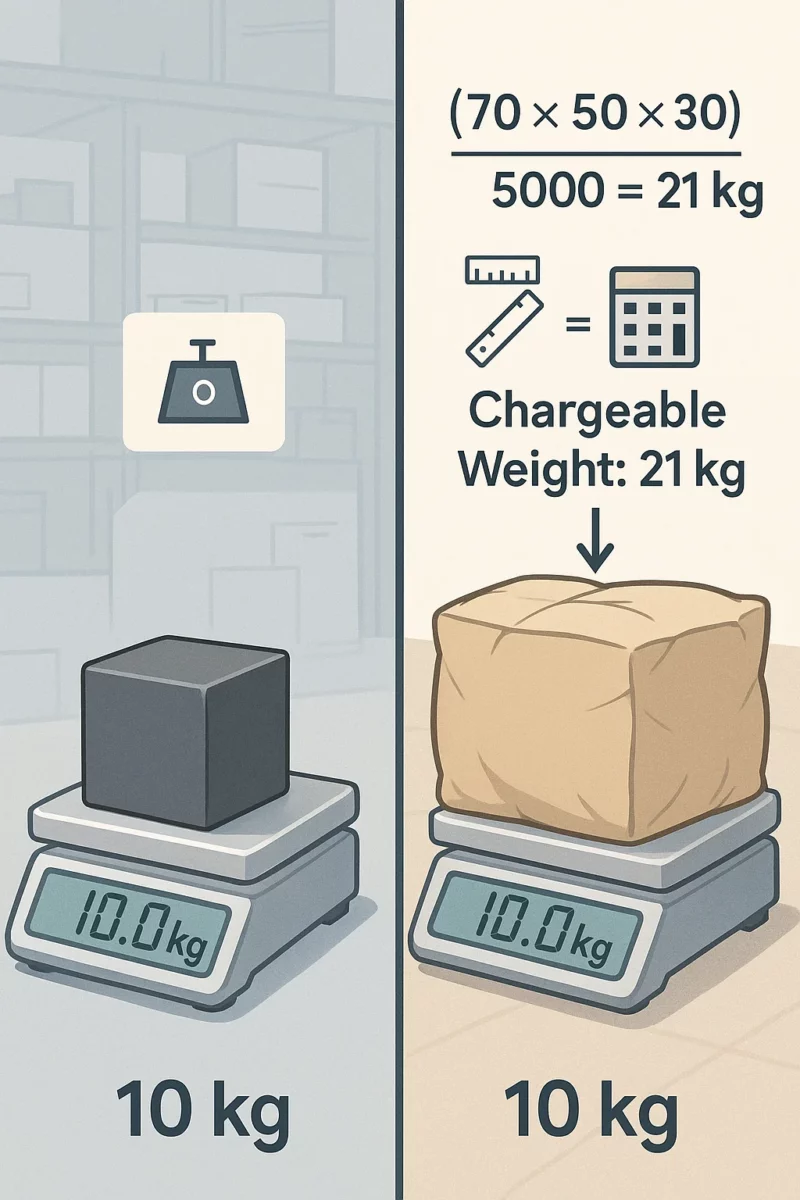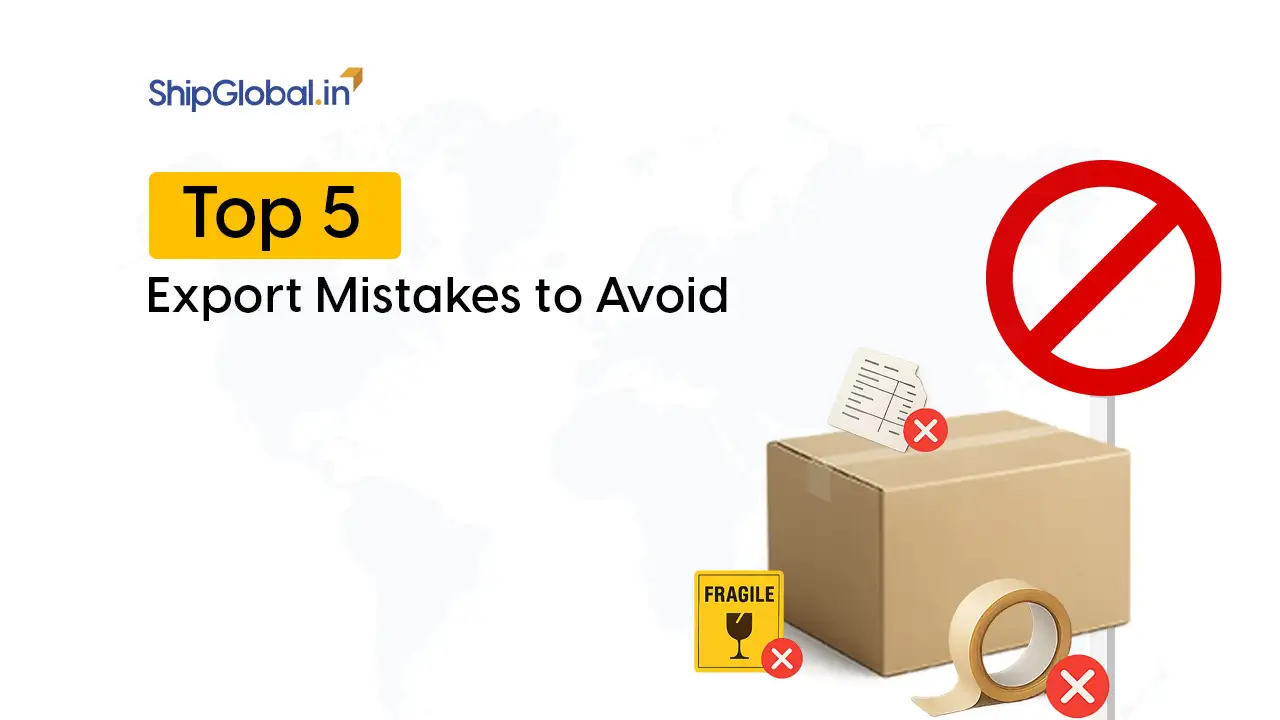If you’ve ever shipped a parcel and thought, “Why am I being charged for more weight than my package is?”, you’re not imagining things. This confusion is widespread and boils down to one core concept: the difference between actual weight and volumetric weight (also known as dimensional weight or cubic weight).
Shipping isn’t just about kilograms or pounds on a scale; it’s also about space. And space, in the logistics world, is money.
Understanding how weight calculation in courier shipments works can help you reduce shipping charges with accurate dimensions, choose better packaging, and ultimately save on costs, whether you’re sending one parcel or managing hundreds of deliveries every month.
Let’s dive deep into how couriers calculate what you pay, why parcel weight measurement isn’t just about what the scale says, and how you can take control of your shipping costs.
What is Actual Weight
Actual weight is the most straightforward concept in courier shipments. It’s the physical weight of your package, which you’d see if you placed it on a digital scale.
Sounds simple. If a box weighs 6 kg, then it should be billed as 6 kg.
But that’s not the full story. Because when that 6 kg box is oversized, it’s probably taking up more space than its fair share in the delivery truck. That’s where volumetric weight comes into play.
What is Volumetric (or Dimensional) Weight
Volumetric weight, also called dimensional weight or cubic weight, is a theoretical number used by couriers to calculate the space your parcel occupies relative to its actual weight. The more space your package takes up, the more it may cost to ship, regardless of how light it is.
To put it simply: couriers charge for weight and for space. The higher of the two becomes the chargeable weight, and that’s what you pay for.
So if your package is lightweight but bulky, your costs go up, even though the actual weight is low. That’s why understanding shipping weight formulas is critical to shipping smarter.
The Shipping Weight Formula: How It Works
Here’s the industry-standard weight calculation for courier shipments:
Volumetric Weight (kg) = (Length x Width x Height in cm) ÷ 5000
Let’s say your package dimensions are 70 cm x 50 cm x 30 cm. Plug those into the formula:
(70 × 50 × 30) ÷ 5000 = 21 kg
Even if the actual weight of your parcel is only 10 kg, the courier will charge you based on 21 kg, the volumetric weight, because it’s higher.
And here’s the important part: chargeable weight is always the higher of the two, either the actual weight or the volumetric weight.
Different couriers may use different divisors (some use 4000 or 6000, depending on shipping method), but the principle remains the same: large packages with low physical weight can cost a lot more than you’d expect.

Why Do Couriers Use Volumetric Weight
Couriers operate on efficiency. Every vehicle, plane, or container has limited space. If you send a large, light package (think pillows or plastic storage bins), it consumes more space than a small, dense package, even if it weighs much less.
That’s why dimensional weight helps couriers balance space and cost. Without it, they’d lose money shipping large but light items.
It also affects courier billing for fragile and large boxes. These types of shipments often require extra space, padding, or specialized handling, which increases volumetric weight and your costs.
The Real-World Impact on Your Shipping Costs
If you’re shipping lightweight bulky items, like clothing, bedding, sports equipment, or packaging materials, you’re likely paying more due to volumetric weight. And if you’re not aware of this, you might miscalculate costs or undercharge customers on shipping.
This is where parcel weight measurement becomes a strategic tool. It’s not just about the numbers, it’s about how to package smarter and make business decisions based on accurate data.
For e-commerce businesses, exporters, and regular shippers, ignoring dimensional weight can erode profit margins. It’s essential for cost optimization in shipping.
Smart Packaging: Your Key to Controlling Courier Costs
The best way to reduce shipping charges with accurate dimensions is through smart packaging. That means:
- Using the smallest box that fits the product securely
- Reducing space inside the package
- Choosing packing materials that offer protection without excessive bulk
The goal is to reduce the volumetric weight without compromising the integrity or safety of the product. If you’re shipping fragile items, you can still use protective materials, just not to the point where you’re doubling the size of your package.
These decisions can have a major effect on the impact of packaging on freight charges. Even a few centimeters of excess in box size can bump you into the next price tier for chargeable weight.
By designing packages around both size and strength, you engage in smart packaging for courier cost savings, and it can make a huge difference across hundreds of shipments.
Export Parcel Packing Tips: Plan Like a Pro
When shipping internationally, space becomes even more valuable. Understanding export parcel packing tips can help you comply with courier rules and minimize dimensional weight charges.
- Avoid irregular shapes, as they often result in higher cubic weight.
- Don’t use oversized boxes unless necessary.
- Pre-measure the product and find a box that leaves minimal space.
- Batch similar-sized items together to optimize space.
All of this helps control parcel weight measurement and prevents unnecessary surcharges.
Courier Billing: What You’re Really Paying For
You’re not just paying for your package to move from point A to point B. You’re paying for:
- The actual weight
- The volumetric weight
- The space it takes up in transit
- The packaging impact, especially for large or fragile items
And what’s on your invoice? The chargeable weight, the highest of the two. That’s why it’s so important to understand what you’re being billed for and how to manage it proactively.
Final Thoughts: Take Control of Your Shipping Costs
In the world of logistics, actual weight, volumetric weight, and chargeable weight are more than just numbers; they are cost drivers. By mastering shipping weight formulas, using precise parcel weight measurement, and implementing smart packaging for courier cost control, you can turn shipping into a competitive advantage.
The next time you’re preparing a package, whether it’s a single parcel or bulk export, remember: you’re not just managing weight, you’re managing space, structure, and strategy.
And that’s how you win at shipping!
FAQs
Actual weight refers to the physical weight of a parcel as measured on a scale. Volumetric weight (also known as dimensional weight or cubic weight) is a calculated figure based on the space occupied by the package. Couriers use the higher of the two, known as the chargeable weight, to determine shipping costs.
The standard shipping weight formula is:
Volumetric Weight (kg) = (Length × Width × Height in cm) ÷ 5000
This formula helps determine the dimensional weight. If the result is higher than the actual weight, the courier will use this as the chargeable weight.
Couriers need to account for the space a parcel occupies, especially when shipping lightweight bulky items. A large, light box takes up more room in trucks or planes than a small, heavy one. Charging based only on actual weight would lead to space inefficiencies and revenue loss for the courier.
Yes, cubic weight is another term for volumetric weight or dimensional weight. It represents the weight equivalent of the space a package occupies and is used in weight calculation for courier services.
Use smart packaging for courier cost savings. This means selecting boxes that closely fit your items, minimizing space, and using protective materials efficiently. Reduce shipping charges with accurate dimensions by measuring every parcel precisely before sending.








